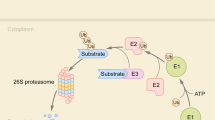Abstract
Leukotriene (LT) A4 hydrolase/aminopeptidase (LTA4H) is a bifunctional zinc enzyme that catalyzes the biosynthesis of LTB4, a potent lipid chemoattractant involved in inflammation, immune responses, host defense against infection, and PAF-induced shock. The high resolution crystal structure of LTA4H in complex with the competitive inhibitor bestatin reveals a protein folded into three domains that together create a deep cleft harboring the catalytic Zn2+ site. A bent and narrow pocket, shaped to accommodate the substrate LTA4, constitutes a highly confined binding region that can be targeted in the design of specific anti-inflammatory agents. Moreover, the structure of the catalytic domain is very similar to that of thermolysin and provides detailed insight into mechanisms of catalysis, in particular the chemical strategy for the unique epoxide hydrolase reaction that generates LTB4.
This is a preview of subscription content, access via your institution
Access options
Subscribe to this journal
Receive 12 print issues and online access
$189.00 per year
only $15.75 per issue
Buy this article
- Purchase on Springer Link
- Instant access to full article PDF
Prices may be subject to local taxes which are calculated during checkout




Similar content being viewed by others
Accession codes
References
Samuelsson, B., Dahlén, S.-E., Lindgren, J.-Å., Rouzer, C.A. & Serhan, C.N. Science 237, 1171–1176 (1987).
Chen, X.S., Sheller, J.R., Johnson, E.N. & Funk, C.D. Nature 372, 179–182 (1994).
Yokomizo, T., Izumi, T., Chang, K., Takuwa, Y. & Shimuzu, T. Nature 387, 620–624 (1997).
Griffiths, R.J. et al. J. Exp. Med. 185, 1123–1129 (1997).
Bailie, M.B. et al. J. Immunol. 157, 5221–5224 (1996).
Byrum, R.S., Goulet, J.L., Snouwaert, J.N., Griffiths, R.J. & Koller, B.H. J. Immunol. 163, 6810–6819 (1999).
Devchand, P.R. et al. Nature 384, 39–43 (1996).
Corey, E.J. Experientia 38, 1259–1381 (1982).
Wetterholm, A. et al. Proc. Natl. Acad. Sci. USA 89, 9141–9145 (1992).
Örning, L. et al. J. Biol. Chem. 266, 16507–16511 (1991).
Matthews, B.W., Fenna, R.E., Bolognesi, M.C., Schmid, M.F. & Olson, J.M. J. Mol. Biol. 131, 259–285 (1979).
Groves, M.R. & Barford, D. Curr. Opin. Struct. Biol. 9, 383–389 (1999).
Holmes, M.A. & Matthews, B.W. J. Mol. Biol. 160, 623–639 (1982).
Mueller, M.J. et al. Proc. Natl. Acad. Sci. USA 92, 8383–8387 (1995).
Blomster Andberg, M., Hamberg, M. & Haeggstrom, J.Z. J. Biol. Chem. 272, 23057–23063 (1997).
Mueller, M.J. et al. Proc. Natl. Acad. Sci. USA 93, 5931–5935 (1996).
Blomster, M., Wetterholm, A., Mueller, M.J. & Haeggström, J.Z. Eur. J. Biochem. 231, 528–534 (1995).
Luciani, N. et al. Biochemistry 37, 686–692 (1998).
Barret, A.J., Rawlings, N.D. & Woessner, J.F. In Handbook of proteolytic enzymes. (eds Barret, A.J., Rawlings, N.D. & Woessner, J.F.) 994–996 (Academic Press, London, San Diego; 1998).
Wetterholm, A. et al. Biochim. Biophys. Acta 1080, 96–102 (1991).
Otwinowski, Z. In Data collection and processing. Proceedings of the CCP4 study weekend. 56–62 (SERC Daresbury Laboratory, Warrington, UK; 1993).
Collaborative Computing Project Number 4. Acta Crystallogr. D 50, 760–763 (1994).
Otwinowski, Z. In Isomorphous replacement anomalous scattering. Proceedings of the CCP4 study weekend. 80–85 (SERC Daresbury Laboratory, Warrington, UK; 1991).
de La Fortelle, E. & Bricogne, G. Methods Enzymol. 276, 472–494 (1997).
Abrahams, J.P. & Leslie, A.G.W. Acta Crystallogr. D 52, 30–42 (1996).
Tronrud, D.E. Acta Crystallogr. A 48, 912–916 (1992).
Kraulis, P.J. J. Appl. Crystallogr. 24, 946–950 (1991).
Vriend, G. J. Mol. Graphics 8, 52–56 (1990).
Acknowledgements
We thank A. Thompson at BM14 and D. Logan for help during data collection and setting up SHARP refinement, M. Andberg for the plasmid pT3-MB4 and E. Ohlsson for technical assistance, as well as A. Wetterholm and B. Samuelsson for helpful discussions and advice. We also would like to thank personnel at beamline X25 of the NSLS, Brookhaven, and I711 of MAX-Lab, Lund, for preliminary data not used in this article. The work was funded by the Swedish Natural Sciences Research Council, the Swedish Medical Research Council, The European Union, and Konung Gustav V:s 80-Årsfond.
Author information
Authors and Affiliations
Corresponding author
Rights and permissions
About this article
Cite this article
Thunnissen, M., Nordlund, P. & Haeggström, J. Crystal structure of human leukotriene A4 hydrolase, a bifunctional enzyme in inflammation. Nat Struct Mol Biol 8, 131–135 (2001). https://doi.org/10.1038/84117
Received:
Accepted:
Issue Date:
DOI: https://doi.org/10.1038/84117
This article is cited by
-
Substrate-dependent modulation of the leukotriene A4 hydrolase aminopeptidase activity and effect in a murine model of acute lung inflammation
Scientific Reports (2022)
-
Bioinformatic mapping of a more precise Aspergillus niger degradome
Scientific Reports (2021)
-
The crystal structure of mycobacterial epoxide hydrolase A
Scientific Reports (2020)
-
The enzymology of human eicosanoid pathways: the lipoxygenase branches
Molecular Biology Reports (2020)
-
Structural characterization of plasmodial aminopeptidase: a combined molecular docking and QSAR-based in silico approaches
Molecular Diversity (2019)



